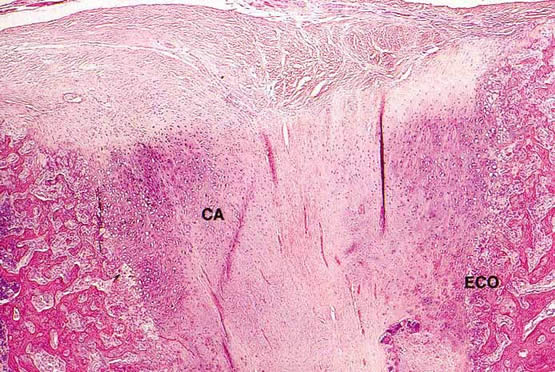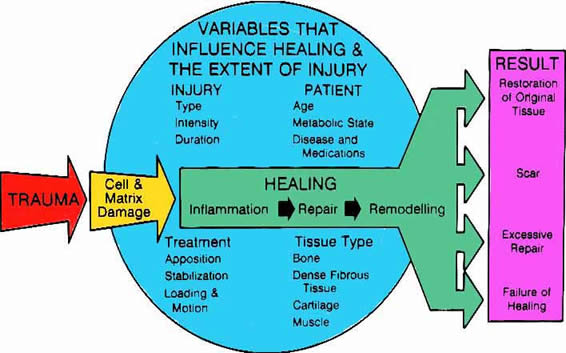Fractures in General
Fractures (broken bones) are a fascinating subject. Maybe that's why I am an orthopedist! There has been a lot of research into fractures, so we know a lot about them. For instance, did you know that bones are the only tissue in the body that does not heal with scar? Skin heals with scar tissue, liver lacerations heal with scar, heart muscle heals with scar. Only bone heals with its original tissue, bone! Read on to find out more about your fracture. Remember, patient education is one of the most important things that I do, and it is the way you can best help yourself.
Stages of Fracture Healing

Stage I, or The Inflammation Stage
The fracture healing starts with the bleeding, tenderness, and swelling your are experiencing now (if you are here because I just saw you for a fracture). In fact, these are not only present now, but are absolutely necessary. (I am here referring to the tenderness of inflammation, not the pain of your fracture. The cast or splint you are in is designed, among other things, to help limit your pain. For more on pain and how it is managed in my practice, click here.) If you could magically prevent the body from having any bleeding, inflammation, or swelling, the fracture would not heal. The first few days to weeks is called Stage I, or the Inflammatory Stage, of bone healing. It is actually a very complex symphony of cellular changes modulated by cytokines, which are protein chemical messengers. It sets up the second stage, the Reparative Stage. You can see from the diagram above that the two stages overlap. In the hand, the Inflammatory Stage continues for about a month.
Stage II, or The Reparative Stage
This is the stage where your fracture gets "healed", that is, the bone ends become joined and stabilized. It is a very complex cellular symphony, again modulated by cytokines just like Stage I. The cells of the body that are capable of changing into bone cells (pleuripotential mesenchymal cells) are induced to do so, and start laying down lots of new bone tissue. This tissue is very weak, so the body has to put down a lot of it. We call this fracture callus (see picture below), and you will see it in your xray on your follow-up visits. (I will always show you your xrays and discuss them with you at each visit. Fracture healing is too important to you, and much too interesting to me, not to share it with you.) The Reparative Stage, in the hand, starts within a week or two and continues for many months.
Stage III, or The Remodeling Stage
This is the final stage, where your body changes the weak bone material into strong bone material. Because this new material is so strong, you don't need a lot of it, and the body will remodel the fracture callus down to a normal sized bone. The cell density increases, the collagen (the fibers that give your bone tensile strength) reorient along the lines of stress, and the bone material itself (a matrix of hydroxyapetite crystals) increases in strength. This stage also overlaps the previous stage. In the hand, the Remodelling Stage continues for many months to a few years in adults.


These are photomicrographs of a healing fracture in a rat (no, I don't cut open my patients to look at the fracture healing!) at about four weeks of healing. The pink material is bone, M stands for the medulary canal (the hole in the middle of the bone). The fracture is indicated by the arrow. CA is the cartilage, which is often formed as a part of early healing of fractures. (With the right treatment, the cartilage turns into bone. If the fracture is not immobilized well enough, it may stay as cartilage, and that can be a problem.) ECO is the area where the cartilage is changing into bone. CX stands for cortex, the original bone before the fracture. All the material above the CX is the healing callus I mentioned earlier, in the Reparative Stage. The fracture callus is about 4 times (400 %) as big as the bone, in this case. In humans, a fracture treated with a cast, splint, or surgery is usually only about 25 to 100 % larger than the bone. The square is the area which is shown at the right, magnified. (Original magnification, 25X and 125 X; photos from the Journal of Bone and Joint Surgery, 82A, 2000, p 164.)
Variables that Influence Healing

There are many variables that affect fracture healing. Some are diagrammed above. There are also many other factors, and these may be age, fracture, or bone dependant. That is what makes orthopedics so interesting. We will discuss the factors of healing, and the unique problems with your fracture, when you are in the office. I look forward to seeing you. (The above diagram is from the text Fractures, by Rockwood and Green, 1991, page 182.)

Your fracture will cause some discoloration of your skin. This bruising is called "ecchymosis" and is normal.
